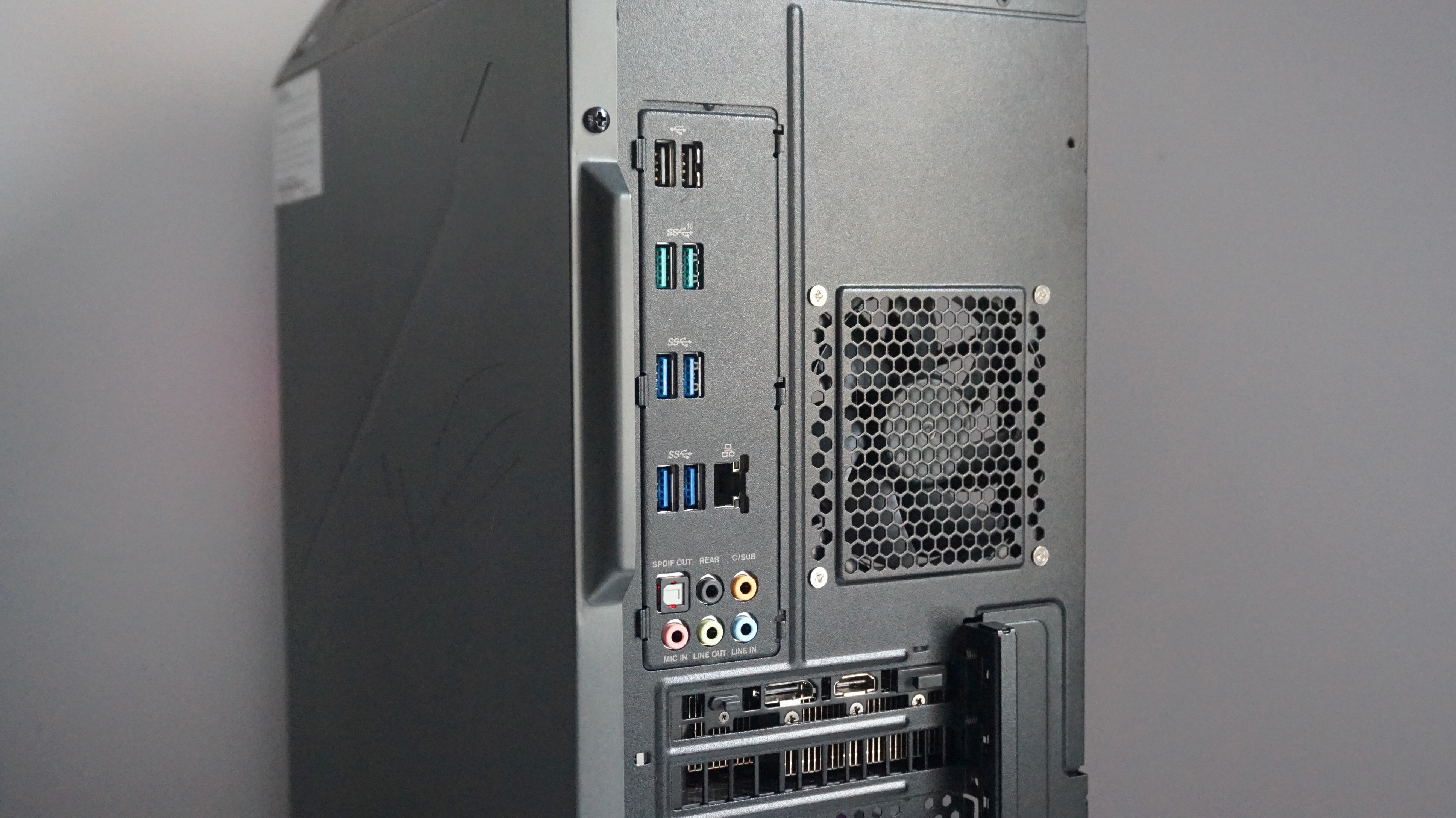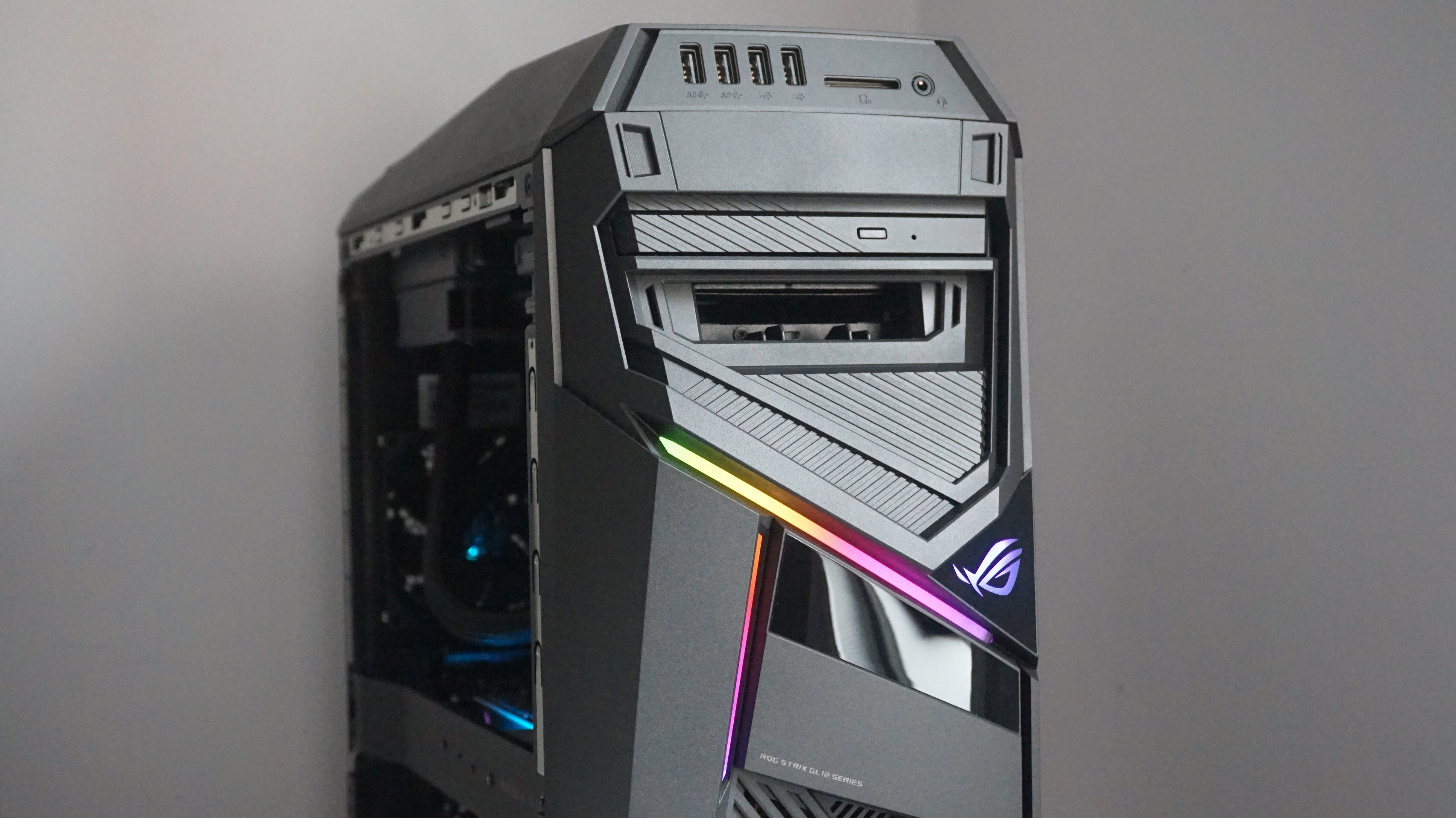
It’s not typically I’ve significantly robust emotions about PC instances, however man alive there’s lots occurring with Asus’ new ROG Strix GL12CX desktop. You’ve received your swishes, your slashes, your grilles and your grates, matt versus gloss versus RGB lighting, and even a full-blown chasm because of its hot-swap SSD bay. It’s lots to soak up, however offered you will get over its many-textured exterior, there’s a ship load of energy to be present in its water-cooled innards, together with an Intel Core i9-9900Okay processor, 32GB of RAM and an Nvidia GeForce RTX 2080 graphics card.
Of course, with a spec like that, the GL12CX is of course a tad costly. £3000, to be exact, when it launches late this November, though there can be an ever-so-slightly cheaper configuration with a Core i7-9700Okay and 16GB of RAM accessible for £2500 as effectively (which can also be the mannequin you’ll discover within the US for a princely $3300). “Three grand!?” I hear you exclaim. “A PC can’t possibly be worth that much!” Well, that’s what we’re about to seek out out. Let’s have a look.
The very first thing I’ll let you know is that this factor is goddamn loud. Despite its Core i9 CPU being hooked as much as a water cooler tucked away within the prime of the PC, I believed I’d immediately been transported to an airport hangar the primary time I turned this on, so loud and deafening have been its numerous followers and whizz pop machines.
Its efficiency profile was, admittedly, set to ‘Turbo’ in Asus’ onboard ROG Armoury Crate software program, however even choosing one of many GL12CX’s quieter profiles (and making a barely bigger air hole down the aspect by swapping out its black aspect panel for the bundled tempered glass one) was nonetheless louder than I’d like. This might be right down to the truth that it not solely has a fairly titchy rear exhaust in comparison with your typical desktop setup, however its RTX 2080 GPU additionally falls into the marginally much less environment friendly ‘blower’ class, too, giving it only one somewhat tiny fan to play with somewhat than two or three jumbo ones that take up your entire width of the cardboard.
Still, whereas the GL12CX doesn’t paint a very promising image for these searching for a little bit of peace and quiet, the upside of all this additional wind energy is that it does allow you to run its ninth Gen Intel Coffee Lake CPU at its full 5.0GHz Turbo Boost velocity, if not a bit greater in the event you fancy overclocking it. This would possibly sound a bit counterintuitive at first – in spite of everything, we’d usually anticipate issues to run at their anticipated speeds once you’re spending this a lot cash on them – however as we noticed in my Intel Core i9-9900K review, this can be a chip that requires some substantial cooling to get probably the most out of it.
Indeed, I used to be capable of comfortably overclock the GL12CX to run at a most velocity of 5.1GHz earlier than it conked out on me, which is much more spectacular than the highest velocity of simply 4.7GHz I managed with the processor after I solely had a daily tower fan caught on it. Overclocking didn’t truly make an enormous quantity of distinction to my benchmark scores, all informed (its Cinebench R15 single core rating elevated from 212 to 216, whereas its multicore rating went from 2080 to 2109), however in the event you’re shopping for a 3 grand system with a £600 / $580 CPU inside it, I’d argue you’d wish to make rattling certain it runs as quick as Intel meant.
The solely downside is that I’m simply not satisfied anybody actually wants a Core i9 of their gaming PC proper now. Sure, it’ll make your games run sooner at 1920×1080 and 2560×1440, however once you’ve received an RTX 2080 within the trunk, I reckon you’re more likely going to be utilizing this as a 4K gaming system the place the distinction between a Core i9 and its considerably cheaper Core i7-8700Okay / Ryzen 7 2700X rivals is virtually naff all.
I can’t converse but to how Intel’s new Core i7-9700Okay performs by means of comparability, however except you’re going to be utilizing the GL12CX for some critical ‘creative’ functions like video modifying, animation rendering or skilled picture work, then I believe you’ll be a lot better off going for the GL12CX’s cheaper specification somewhat than this one.

On the again of the GL12CX, you get two USB2 ports, two USB 3.1 Gen 2 ports, 4 USB 3.1 Gen 1 ports, Gigabit Ethernet, an optical S/PDIF and 5 audio jacks.
After all, you’re nonetheless getting an RTX 2080 with the Core i7 system, which, as we’ve additionally found in my Nvidia GeForce RTX 2080 review, is about as quick as considered one of right this moment’s GTX 1080Ti playing cards – that’s, a minimum of in the case of uncooked efficiency, as a result of there’s nonetheless no method of testing any of its Turing GPU’s best features but, equivalent to its AI-powered and performance-enhancing DLSS magic or its fancy gentle reflection ray-tracing tech.
This ought to hopefully change quickly, though given the delay on Shadow of the Tomb Raider and Final Fantasy XV’s respective RTX updates (which have been meant to reach in October), it might nonetheless be a number of extra months earlier than the RTX 2080 begins to really feel like good worth for cash. Instead, proper now, it falls into just about the identical class as its Core i9 CPU for me, in that it’s one other extravagant luxurious merchandise somewhat than an excellent use of your cash.
Still, there’s no denying this can be a highly effective piece of {hardware}, and also you’re just about a system that may comfortably deal with games at 60fps or above on max settings at 1080p and 1440p, in addition to a gradual 60fps on medium to excessive settings at 4K.
For occasion, I not solely noticed a median body fee of 73fps in Hitman on Ultra settings at 4K, however I additionally noticed a median of 74fps in Forza Horizon 4‘s 4K Ultra settings as well, the latter reaching as high at 84fps on occasion. Similarly, the GL12CX’s RTX 2080 blitzed by way of Doom at a fee of as much as 110fps at 4K Ultra settings, with the body fee by no means dipping beneath 87fps.

On the entrance panel, you’ll discover two USB 3.1 Gen 1 and two USB2 ports, plus an SD card reader, a mixed headphone and microphone jack and *shockhorror* a 9mm optical disk drive for DVDs.
Elsewhere, I needed to make a few tweaks to get a gradual 60fps, nevertheless it didn’t take a lot compromise to get the remainder of my benchmarking suite working good and easily. In Assassin’s Creed Odyssey, for instance, it managed a gradual 54fps common on High at 4K, however you’ll nonetheless get a superbly playable common of 41fps in the event you go for its prime Ultra High setting at this decision. Similarly, persist with Shadow of the Tomb Raider‘s SMAA anti-aliasing setting, and you’ll see round 40-50fps on Highest, or nearer to 50-60fps on High.
I additionally noticed between 50-60fps in The Witcher 3 on High at 4K, nevertheless it was clearly extra comfy on Medium, with digital camera pans turning into a heck of lots smoother as soon as the body fee reached 60-72fps. The identical factor occurred in Total War: Warhammer II as effectively. While High nonetheless produced a really playable common of 51fps in its battle benchmark, it was solely as soon as I switched to Medium that it jumped as much as that good 60fps.
Final Fantasy XV was additionally a little bit of powerful buyer for the RTX 2080 at 4K, particularly if you wish to use all of Nvidia’s fancy hair, turf and lighting results. Indeed, I needed to flip all these off and accept its Average high quality setting to get wherever close to 60fps at this decision (with High coming in round 40-44fps when rambling throughout the hills of Duscae), so in the event you’re after the quadruple whammy of HairWorks, TurfEffects, Shadowlibs and VXAO lighting, you’ll must play at 2560×1440.
Not that there’s something unsuitable with utilizing an RTX 2080 for enjoying at 1440p, in fact, particularly when it does such a rattling good job of it, too. Indeed, throughout the board I used to be capable of get 60fps or extra on max settings with each game in my benchmarking suite at this decision, making it a good selection for these with excessive refresh fee displays in addition to these aiming for 4K.

The hot-swap 2.5in SSD bay (which Asus reckons makes the GL12CX ‘esports-ready’) may be lined up with a snap-on little bit of plastic in the event you want.
In phrases of storage, you’re well-served in general capability, however the velocity of the GL12CX’s major drive leaves one thing to be desired. With the Core i9 spec, for example, you get a 512GB Samsung branded NVMe SSD and a 2TB HDD, whereas the Core i7 spec nets you a 256GB NVMe SSD and a 1TB HDD.
Unfortunately, regardless of the Samsung DNA, the GL12CX’s NVMe drive isn’t wherever close to as quick as Samsung’s 970 Evo. In the AS SSD benchmark, for instance, the GL12CX’s drive got here in with a random 4K learn velocity of 32MB/s and a random 4K write velocity of 107MB/s. That’s 42% slower on studying, and 28% slower on writing. It’s nonetheless pretty respectable as this stuff go, however contemplating the remainder of the PC’s high-end spec I hoped for one thing a bit sooner. The HDD, in the meantime, is as sluggish as you’d anticipate, so I’d use that for sticking your images, music and lesser-used games on in the event you can presumably assist it.
Overall, then, the Asus ROG Strix GL12CX feels extra like a PC for bragging rights sake in the mean time somewhat than one which’s good worth for cash. Sure, it’s a one-stop store for lots of the most effective parts round right this moment – which for some individuals can be pretty much as good a cause as any to exit and get it – however the advantages you’ll achieve over cheaper Core i7/GTX 1080Ti methods on the market (which may be had for nearer to 2 grand judging from a fast customisation spec I made up over at Scan) are arguably fairly minimal.
I’m positively not satisfied in regards to the want for a Core i9 proper now, and whereas the RTX 2080 might effectively begin to present its true worth over the GTX 1080Ti as soon as builders begin getting their numerous RTX updates on the market (see right here for a full checklist of all of the confirmed RTX games so far ), it’s nonetheless too early to say whether or not the potential efficiency achieve is absolutely going to be price all that additional money. There are nonetheless a few weeks earlier than the GL12CX goes on sale, in fact, however for now I’d advise to carry off a short time longer to see if Nvidia’s proposed RTX updates can shift the goalposts in Asus’ favour.



